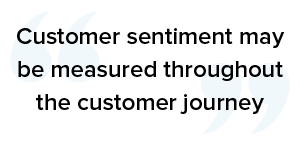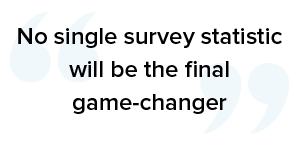This blog series began with “How Call Center QA Improves NPS and Customer Experience,” continued with “Correlating NPS and QA Scoring: Driving Shareholder Value” and "Understanding the Customer Journey through Your Contact Center" as we address how Quality Assurance in the contact center is being used by organizations, large and small, to improve NPS and overall customer experience. This blog post is the fourth and final in the series.
Let us begin by defining customer sentiment, why and how it should be measured. There are indeed a variety of survey tools available that may be used to collect, analyze, and ultimately work to improve customer sentiment, but before looking closer at these options, it is wise to understand why customer sentiment is so important in the first place.
Customer sentiment is a general feeling or attitude customers have about a particular brand and their willingness to invest in that brand. It is defined as an “economic indicator of the overall health of the economy,” or a particular brand or business, as determined by consumer opinion.
Companies and call centers wanting to thrive will obviously want to drive positive customer sentiment to ensure the continued health of their organizations.

Customer sentiment may be measured a number of times throughout the customer journey. The exact timing of which, will vary based on the company, type of customer, and customer needs and challenges. Generally, as a customer interacts with a brand, there are a variety of touchpoints that naturally lend themselves to measurable statistics via net promoter scoring or customer satisfaction surveys.
An example for our purposes might be a survey issued at the end of a customer service call. Survey owners usually reside in the Marketing Department but increasingly include quality and call center managers who are trying to understand the impact service delivery has on sentiment and wanting to share their learnings with the larger team and executives. Surveys may measure levels of customer satisfaction based on specific products, services, and interactions. A survey may also gauge a customer’s overall feeling (or sentiment) for the company as a whole.
Marketing Department but increasingly include quality and call center managers who are trying to understand the impact service delivery has on sentiment and wanting to share their learnings with the larger team and executives. Surveys may measure levels of customer satisfaction based on specific products, services, and interactions. A survey may also gauge a customer’s overall feeling (or sentiment) for the company as a whole.
Of course, how these surveys are delivered and what question or questions are asked may make all the difference, not only in survey completion rates, but in achieving strong scores that tell a story executives can take direct action upon to improve.
The goal of giving a survey is to get feedback that is both accurate and actionable. The first priority though is to ensure high survey completion rates. Total survey data is only statistically relevant if there is a high enough volume of completed surveys to make them so.
Surveys with the highest completion rates fulfill the following best practices. They are:
It is a necessary requirement that the survey creation and implementation process be one that is both thoughtful and goals-based.
Many survey tools are standalone and require the importing of a contact list to issue invites or a static weblink posted on a website. Integrated survey tools are designed to collect CSAT or NPS customer sentiment data where the invite is delivered immediately after a given customer interaction.
Invites can be automated by integrating into the CRM platform so that they are triggered by events in the CRM such as closing a case or sale. These surveys record the aptly named “moment of truth” that follows directly after a customer interacts with an agent.

Embedding surveys with your CRM and integrating results into the Quality Assessment platform will streamline continuous customer sentiment measurement.
A real and immediate benefit is that call center managers can own this entire process without relying on outside departments to collect valuable customer data. Results are available in near real time allowing managers to act on the insights.
The results are granular so that customer sentiment can be associated with individual event types, teams or agents. Comparing and contrasting internal quality scores and external customer sentiment results at a team and agent level delivers a deeper understanding of the cause and effect of service delivery.
The surveys may be delivered in a variety of ways -- email, SMS-messaging - with automated reminders to encourage customers to complete the surveys. These integrated survey tools provide quick and consistent results that are highly efficient feedback mechanisms.
They deliver actionable call center learnings uncovering the close connection between the interaction with an agent and the impression that leaves on the customer.
Integrated survey tools, when used correctly and in accordance with best practices,  help the call center manager correlate internal QA scores with the customers experience for improved call center QA, this will drive home results and insights resulting in operational improvements that give customer sentiment a boost, ultimately improving sales and retention. However, it is important to remember that no single survey statistic will be the final game-changer but NPS is becoming a standardized ‘Killer’ question. Keep in mind that customer feelings are not and should not be easy to objectively identify given all the variables. There is, for better or worse, no one true quick fix when it comes to customers who have such a variety of uniquely personal needs and challenges, but the goal is to identify trends that indicate cause and effect and can be quantified in impactful ways.
help the call center manager correlate internal QA scores with the customers experience for improved call center QA, this will drive home results and insights resulting in operational improvements that give customer sentiment a boost, ultimately improving sales and retention. However, it is important to remember that no single survey statistic will be the final game-changer but NPS is becoming a standardized ‘Killer’ question. Keep in mind that customer feelings are not and should not be easy to objectively identify given all the variables. There is, for better or worse, no one true quick fix when it comes to customers who have such a variety of uniquely personal needs and challenges, but the goal is to identify trends that indicate cause and effect and can be quantified in impactful ways.
Integrating your surveys into your QA and CRM platforms will streamline the gathering of surveys and provide a continuous stream of valuable data allowing the organization to adjust and evolve strategies to improve customer experience with all the benefits that brings.